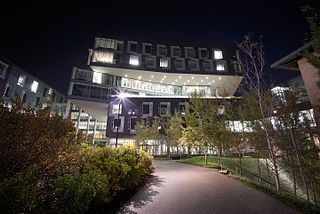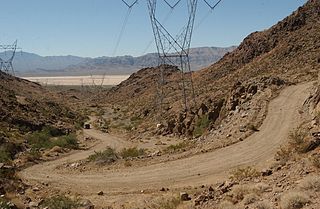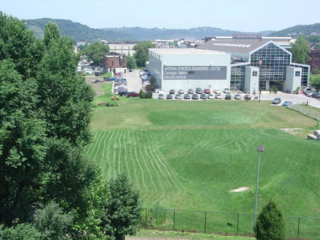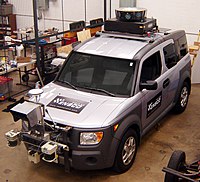
The School of Computer Science (SCS) at Carnegie Mellon University in Pittsburgh, Pennsylvania, US is a school for computer science established in 1988. It has been consistently ranked among the best computer science programs over the decades. As of 2024 U.S. News & World Report ranks the graduate program as tied for No. 1 with Massachusetts Institute of Technology, Stanford University and University of California, Berkeley.
The DARPA Grand Challenge is a prize competition for American autonomous vehicles, funded by the Defense Advanced Research Projects Agency, the most prominent research organization of the United States Department of Defense. Congress has authorized DARPA to award cash prizes to further DARPA's mission to sponsor revolutionary, high-payoff research that bridges the gap between fundamental discoveries and military use. The initial DARPA Grand Challenge in 2004 was created to spur the development of technologies needed to create the first fully autonomous ground vehicles capable of completing a substantial off-road course within a limited time. The third event, the DARPA Urban Challenge in 2007, extended the initial Challenge to autonomous operation in a mock urban environment. The 2012 DARPA Robotics Challenge, focused on autonomous emergency-maintenance robots, and new Challenges are still being conceived. The DARPA Subterranean Challenge was tasked with building robotic teams to autonomously map, navigate, and search subterranean environments. Such teams could be useful in exploring hazardous areas and in search and rescue.

Stanley is an autonomous car created by Stanford University's Stanford Racing Team in cooperation with the Volkswagen Electronics Research Laboratory (ERL). It won the 2005 DARPA Grand Challenge, earning the Stanford Racing Team a $2 million prize.

Sebastian Thrun is a German-American entrepreneur, educator, and computer scientist. He is chief executive officer of Kitty Hawk Corporation, and chairman and co-founder of Udacity. Before that, he was a Google vice president and Fellow, a Professor of Computer Science at Stanford University, and before that at Carnegie Mellon University. At Google, he founded Google X and Google's self-driving car team. He is also an adjunct professor at Stanford University and at Georgia Tech.

William L. "Red" Whittaker is an American roboticist and research professor of robotics at Carnegie Mellon University. He led Tartan Racing to its first-place victory in the DARPA Grand Challenge (2007) Urban Challenge and brought Carnegie Mellon University the two million dollar prize. Previously, Whittaker also competed in the DARPA Grand Challenge, placing second and third place simultaneously in the Grand Challenge Races.

A robot competition is an event where the abilities and characteristics of robots may be tested and assessed. Usually, they have to outperform other robots in order to win the competition. Many competitions are for schools, but several competitions with professional and hobbyist participants also exist.

Announced in 2002, the first DARPA Grand Challenge was a driverless car competition held on March 13, 2004 in the Mojave Desert region of the United States. The 150 miles (240 km) route followed Interstate 15 from just before Barstow, California to just past the California-Nevada border in Primm. None of the robot vehicles finished the route. The vehicle of Carnegie Mellon University's Red Team traveled the farthest distance, completing 11.78 km (7.32 mi) of the course. The $1 million prize remained unclaimed.

The second driverless car competition of the DARPA Grand Challenge was a 212 km (132 mi) off-road course that began at 6:40 am on October 8, 2005, near the California/Nevada state line. All but one of the 23 finalists in the 2005 race surpassed the 11.78 km (7.32 mi) distance completed by the best vehicle in the 2004 race. Five vehicles successfully completed the course:
There are a number of competitions and prizes to promote research in artificial intelligence.
John J. Leonard is an American roboticist and Professor of Mechanical and Ocean Engineering at the Massachusetts Institute of Technology. A member of the MIT Computer Science and Artificial Intelligence Laboratory (CSAIL), Leonard is a researcher in simultaneous localization and mapping, and was the team lead for MIT's team at the 2007 DARPA Urban Challenge, one of the six teams to cross the finish line in the final event, placing fourth overall.
Henrik Iskov Christensen is a Danish roboticist and Professor of Computer Science at Dept. of Computer Science and Engineering, at the UC San Diego Jacobs School of Engineering. He is also the Director of the Contextual Robotics Institute at UC San Diego.
CajunBot refers to the autonomous ground vehicles developed by the University of Louisiana at Lafayette for the DARPA Grand Challenges. CajunBot was featured on CNN and on the Discovery Channel science series Robocars.
The Learning Applied to Ground Vehicles (LAGR) program, which ran from 2004 until 2008, had the goal of accelerating progress in autonomous, perception-based, off-road navigation in robotic unmanned ground vehicles (UGVs). LAGR was funded by DARPA, a research agency of the United States Department of Defense.

The National Robotics Engineering Center (NREC) is an operating unit within the Robotics Institute (RI) of Carnegie Mellon University. NREC works closely with government and industry clients to apply robotic technologies to real-world processes and products, including unmanned vehicle and platform design, autonomy, sensing and image processing, machine learning, manipulation, and human–robot interaction.
Roborace was a competition with autonomously driving, electrically powered vehicles. Founded in 2015 by Denis Sverdlov, it aimed to be the first global championship for autonomous cars. From 2017 to 2019, the official CEO was 2016–17 Formula E champion, Lucas Di Grassi, who later became a member of Roborace’s supervisory board. The series tested their technology and race formats at FIA Formula E Championship events during 2016–2018. In 2019 Roborace organized Season Alpha, which consisted of 4 trial racing events with several independent teams competing against each other for the first time. In 2020–21 Roborace held Season Beta with 7 competing teams. All teams utilized the same chassis and powertrain, but they had to develop their own real-time computing algorithms and artificial intelligence technologies.

Argo AI LLC was an autonomous driving technology company headquartered in Pittsburgh, Pennsylvania. The company was co-founded in 2016 by Bryan Salesky and Peter Rander, veterans of the Google and Uber automated driving programs. Argo AI was an independent company that built software, hardware, maps, and cloud-support infrastructure to power self-driving vehicles. Argo was mostly backed by Ford Motor Co. (2017) and the Volkswagen Group (2020). At its peak, the company was valued at $7 billion.
Ragunathan "Raj" Rajkumar is the George Westinghouse Professor of Electrical and Computer Engineering at Carnegie Mellon University in Pittsburgh, Pennsylvania. He is also affiliated with the Robotics Institute and the Heinz School of Information Systems and Public Policy at Carnegie Mellon University. He also serves as the Director of the Metro21 Smart Cities Institute and as the Director of the Mobility21 USDOT National University Transportation Center at Carnegie Mellon University. He also leads the General Motors-CMU Connected and Autonomous Driving Collaborative Research Laboratory (CAD-CRL), and the Real-Time and Multimedia Systems Lab (RTML) there.
Torc Robotics (Torc), an independent subsidiary of Daimler Truck, is an American autonomous truck company headquartered in Blacksburg, Virginia, with operations in Albuquerque, New Mexico; Austin, Texas; and Stuttgart, Germany. Torc is testing autonomous trucks in Virginia, New Mexico, and Texas and is taking a pure play approach to commercialization – focusing at first on one platform in one region.

Chris Urmson is a Canadian engineer, academic, and entrepreneur known for his work on self-driving car technology. He cofounded Aurora Innovation, a company developing self-driving technology, in 2017 and serves as its CEO. Urmson was instrumental in pioneering and advancing the development of self-driving vehicles since the early 2000s.
Over the years, the U.S. Defense Advanced Research Projects Agency (DARPA) has conducted a number of prize competitions to spur innovations. A prize competition allows DARPA to establish an ambitious goal, which makes public way for novel approaches from the public that might otherwise appear too risky to undertake by experts in a particular discipline.












